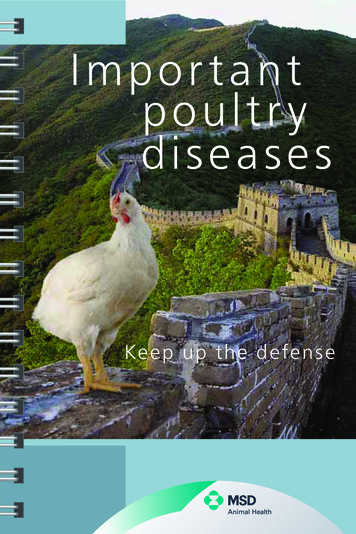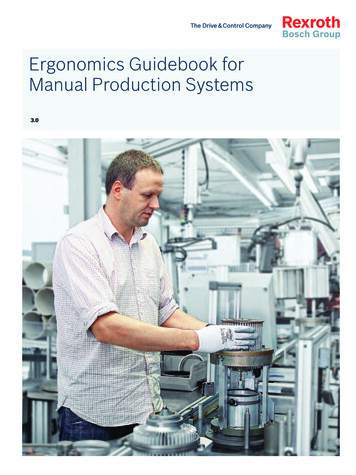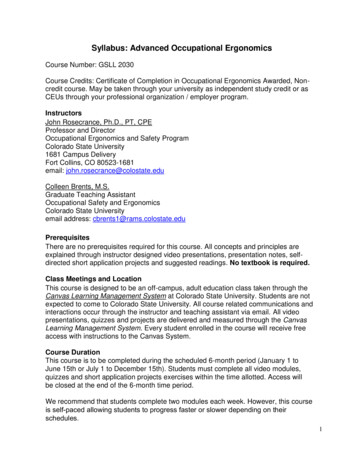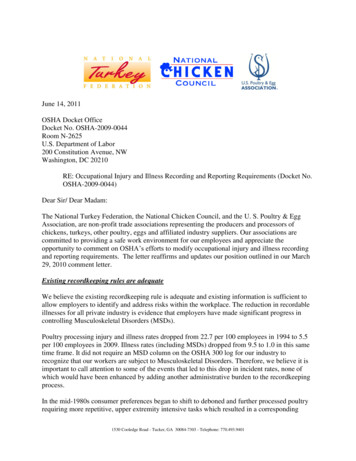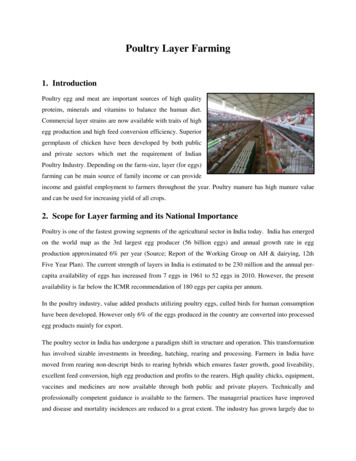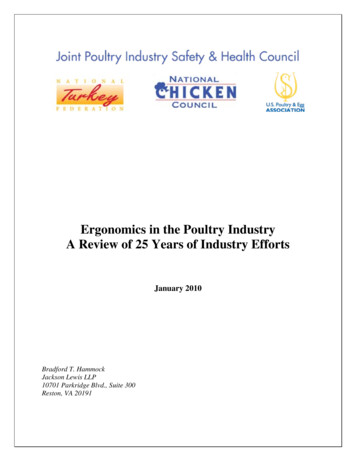
Transcription
Ergonomics in the Poultry IndustryA Review of 25 Years of Industry EffortsJanuary 2010Bradford T. HammockJackson Lewis LLP10701 Parkridge Blvd., Suite 300Reston, VA 20191
Table of ContentsIntroduction1The Industry’s 25 Year Effort on Ergonomics1Decline in MSDs in the Poultry Industry10Implementation of Ergonomics PrinciplesThroughout the Poultry Industry13Next Steps for the Industry?18References19This White Paper is an historical look at the efforts of the poultry industry to implementergonomics in poultry and egg processing facilities. It does not constitute, nor can it beused as evidence to establish, industry recognition of hazards that may or may not existin the poultry industry or feasible means of abatement to address same. It does notestablish a standard of care for poultry processing facilities and may not be used in anyenforcement proceedings brought under the Occupational Safety and Health Act of 1970or any other state or federal law.
IntroductionFor the last twenty-five years, the poultry industry has been at the forefrontof efforts to reduce musculoskeletal disorders (MSDs) in the workplace.MSDs can become serious, debilitating injuries to the men and women thatwork every day at poultry facilities across the country. The industry’sengagement on the prevention and early treatment of MSDs can serve as amodel for other industries that are also facing the challenges of dealing withthe difficult issues associated with these injuries.The poultry industry recognizes that its efforts are ongoing. The preventionof MSDs is a constant challenge. While the past twenty-five years has seena dramatic decrease in the numbers and rates of MSDs occurring in theindustry, the industry cannot afford to stop seeking new and innovativeways to protect its workforce. Since 1992, MSD rates have fallen over75%. The industry has much to be proud of, but more work to do.“Ergonomics in the Poultry Industry: A Review of 25 Years of IndustryEfforts” chronicles the progress made and the successes earned with respectto ergonomics, including the significant decrease in MSDs. It alsodiscusses how OSHA has focused its attention on the poultry industry overthis period and the positive results that have come from joint OSHA andindustry efforts. Finally, it unveils the results of a new survey that thepoultry industry has conducted that gauges the penetration of the industry’sergonomics efforts to poultry facilities across the country.This review is sponsored by the National Chicken Council, the NationalTurkey Federation, and the U.S. Poultry & Egg Association. Collectively,the member companies of these organizations produce approximately 95%of the poultry products in this country and employ hundreds of thousands ofworkers.The Industry’s 25 Year Effort on ErgonomicsPerhaps more than any other industry, the poultry industry over the lastseveral decades has focused its energies on the prevention of MSDs in theworkplace. The work in poultry processing is manually-intensive and thusa proactive approach to MSDs is necessary to ensure the safety and healthof poultry industry workers. The poultry industry was one of the first torecognize the value of implementing ergonomics principles in theworkplace.1
The Industry Develops the Medical Ergonomics Training (MET) ProgramIn the mid-1980s, the industry created a task force to develop acomprehensive, preventative approach to MSDs. With the increasing publicdemand for deboned products in the 1980’s, the incidence of MSDs in theindustry increased. The goal of the task force was to counter this trend anddevelop and distribute a practical document to help the poultry industryreduce the incidence of MSDs. Safety and health professional volunteersfrom the broiler chicken and turkey industries comprised the task force.The task force reviewed several different approaches to reducing MSDs inthe workplace. It ultimately identified the “triad strategy” of training,ergonomics, and medical intervention as the key common denominators forsuccessful preventative efforts and incorporated these concepts into thegroundbreaking document entitled “The Medical Ergonomics TrainingProgram: A Guide for the Poultry Industry” (the “MET Program”). Whatmade the document unique at that time was that it included not only adescription of the general principles of training, ergonomics, and medicalintervention, but also provided specific, practical suggestions for poultryemployers on how to implement the triad strategy. The MET Programdocument was released in 1986.The industry followed the release of the MET Program document with twohands-on training videos to educate poultry processing companies and theiremployees on the triad strategy. “Doing it Right” and “ErgoFit: FittingYour Job to You” were enormously successful at conveying the principlesof medical intervention, ergonomics, and training to employers andemployees throughout the poultry industry.While the MET Program is over 20 years old, it still has value today. Manyof the core concepts developed by the industry in that document werepicked up by others, and even OSHA, in later guidance and regulatorymaterials. Poultry companies can still use the MET Program documenttoday and effectively implement successful solutions to MSDs.2
The “Triad Strategy”TrainingThe MET Program identified seven basic steps to developing and implementing aneffective training program: identify training needs; determine content; determineapproach; select training objectives; select and train trainers; develop trainingactivities; and conduct training.Several key points were also emphasized. First, training must take intoconsideration the existing knowledge base of the individual. Companies shouldnot presume that individuals have the same base level of knowledge with respect toprogram content, hazards at the worksite, and signs and symptoms of MSDs.Second, training in the poultry processing industry should involve practical, handson activities where manual skills are involved. Because of the unique aspects ofthe poultry processing industry, on the job training is a must, from both a businessand safety and health standpoint. And third, all training should be documented.Documentation is particularly useful to ensure that all employees have received therequired training.ErgonomicsThe poultry industry recognized early that implementing ergonomics solutions inthe workplace improves the safety and health of employees, but also improvesbusiness efficiencies. The ergonomics solutions presented included: Proper workstation design, including work elevation and foot support, sitstand, and lighting.Job Methods/Work Practices, including task analysis, methodsmodification, and job rotation.Automation.Hand tools, with good hand design and a strict sharpening schedule.Medical InterventionThe task force also recognized the value of medical intervention in preventing theonset of serious MSDs. The document identified the following as goals of medicalintervention: to minimize employee pain and suffering; maintain employeemorale; maintain efficiency and productivity; and minimize dollar losses. “Earlydetection and aggressive treatment of [MSDs] is a key in averting a problem andperhaps disabling injury,” the task force concluded. The document specificallyidentified early symptoms and treatment for such MSDs as tendinitis, carpal tunnelsyndrome, tennis elbow, and so on.3
Development of the MET Program for SupervisorsRecognizing the key role that supervisors play in injury and illnessprevention, after the successful publication of the MET Program document,the industry developed “The Met Program for Supervisors.” This seconddocument built upon the triad strategy, but targeted guidance to supervisors,who are on the front lines with respect to preventing MSDs in the workplace.The document contained key practical guidance to help supervisors deal withMSDs. In particular, the document emphasized spotting and treatingsymptoms of MSDs early: Pain, swelling, or tenderness of the elbow or shoulder;Limited motion of the arm;Pain, weakness, numbness, clumsiness, and tingling of the hand,especially at night;Lack of sweating of part of the hand;Tenderness when moving the thumb;Crackling or grating sound when extending or bending the thumb;A weak grip;Locking fingers;Fingers that turn pale first, then blue;Pain, swelling, or tenderness of the forearm; andCracking noises when moving the shoulder, elbow, wrist, or thumb.Also described were practical ergonomic solutions, such as work stationheight, foot support, work area design, and sit-stand workstations. Thedocument also emphasized the key to success with ergonomics – havingemployees help with job hazard analyses.The document stressed the need for both formal and informal training, butstated that whenever practical, new or inexperienced workers should bestarted on separate lines set up for training. Supervisors were cautioned notto neglect follow-up. Training must be documented and checked regularly toensure that it is working.4
The Industry Focuses on Information SharingAlso during the 1980’s, and later through the 1990’s, the industryaggressively engaged in focused communication to share the best practiceson ergonomics that were starting to develop. The industry formed the JointPoultry Industry Safety and Health Committee (the “Safety and HealthCommittee” or “Committee”). Started as an ad hoc group of poultry industrysafety and health professionals to improve workplace safety and health in theindustry, the Safety and Health Committee developed a more formalstructure a few years later.One of the early successes of the Committee was to launch, with GeorgiaTech’s Agricultural Technology Research Program (“Georgia Tech” or the“Research Institute”), the annual National Safety Conference for PoultryProcessing in 1984 (the “Poultry Safety Conference”). The goal was to“spread the word” on safety and health in the industry, and, in particular, onthe prevention of MSDs. In 1990 for example, five top ergonomic specialistsworking in the poultry industry spoke at a special afternoon session of thePoultry Safety Conference to discuss ergonomics problem areas andsolutions. Safety and health professionals from virtually all of the poultryprocessing companies throughout the country attend the Poultry SafetyConference each year.The Committee also helped launch with Emory University the industry’sConference on Medical Management of Cumulative Trauma Injuries, whichtook place in 1991, 1993, and 1995. Aimed at poultry industry health careproviders who must respond to MSDs in the workplace, the conferenceshared the latest medical management information amongst thoseprofessionals.The Committee pursued other practical ergonomics improvements duringthis same time period. It engaged Chicago Cutlery to help develop special,ergonomically-designed knives for use in poultry facilities. These kniveswere particularly effective at reducing certain ergonomic risk factors and arestill widely used today. The Committee presented this work along with the“MET Program for Supervisors” to the then-Assistant Secretary of OSHA,who praised the industry’s willingness to proactively engage the problem ofMSDs in the workplace.5
The industry’s close, collaborative relationship with Georgia Tech over thelast twenty years also has resulted in significant improvements in workersafety and health. The mission statement of the Research Institute is topromote the economic growth of Georgia agribusiness (especially the poultryindustry) through: Research focused on the development of new technologies thatimprove productivity and efficiency;Exposure of students to the challenges of developing and adaptingthese technologies;Technical assistance to Georgia-based industry members with specialproblems;Release of information on emerging technologies and improvedoperational management through newsletters, articles, seminars, andpresentations to speed ultimate commercial use.The Research Institute has worked to improve safety and health throughground-breaking research and associated information sharing. Just recently,researchers, in conjunction with certain poultry companies, have beenworking to develop an instrument to assess MSD risk in poultry tasks.Georgia Tech researchers have developed a tool to measure fore- and upperarm muscle stress/strain associated with poultry deboning and cutting tasks.Researchers also anticipate that developments in this area will be expandedto include assessments of the back and other tasks within the poultryprocessing environment.The poultry industry has worked closely with Georgia Tech to developimportant ergonomics materials. At the industry’s urging, the ResearchInstitute applied for and received a Susan Harwood Training Grant fromOSHA to develop a National Ergonomic Training Program. This programprovided state-of-the-art training and materials to plants across the industry.The primary component of the grant was a train-the-trainer course. GeorgiaTech and the industry conducted a three-day ergonomics training coursedesigned to help individuals in the poultry industry who are charged withsetting up and implementing ergonomics training to better understand basicergonomics principles, analysis techniques, design tools, successfulintervention programs, and so forth. Upon completion of the course, the6
trainers could apply what they learned to training employees in their poultryplants, along with training materials provided to them in the train-the-trainersessions.The train-the-trainer course provided 18 hours of classroom interaction onthe following topics: Introduction to ErgonomicsRisk FactorsPhysiology and Anatomy of Hands and ArmsAnthropometry and Workstation DesignPhysiology and Anatomy of the Lower Back and Lifting GuidelinesWorker Safety Analysis TechniquesEngineering and Administrative ControlsSuccessful Ergonomics Program Elements and Case StudiesHelpful Websites and ResourcesOSHA’s Ergonomics AgendaEffective Training TechniquesDemonstrationsAs a result of this important grant program, almost 200 ergonomics trainerswere trained and over 15,000 workers subsequently received ergonomicstraining.Working with OSHA to Improve Safety and HealthRecognizing the key part that OSHA plays in the safety and health of itsworkers, over the last twenty-five years the industry has invested significantresources working with the agency to improve safety and health in poultryfacilities.In 2004, OSHA, with input from the industry, developed ergonomicsguidelines specific to poultry processing. “Ergonomics for the Prevention ofMusculoskeletal Disorders: Guidelines for Poultry Processing” (PoultryGuidelines) was the third in a series of four industry-specific ergonomicsguidelines issued by OSHA over a six year period. For the poultryprocessing industry, the guidelines built upon the concepts included inOSHA’s Ergonomics Program Guidelines for Meatpacking Plants issued in7
the early 1990’s, but tailored them to the unique aspects of poultryprocessing.The Poultry Guidelines described the basic process for addressing MSDs inthe workplace: providing management support, involving employees,identifying problems, implementing solutions, addressing reports of injuries,and evaluating ergonomics efforts.Perhaps the most useful tools for the industry in the document, however,were the solutions identified. The document provided over 20 separatesolutions and examples of PPE. These ranged from workstation designsolutions, to engineering devices, to manual handling solutions. Thedocument also recognized the importance of administrative solutions in thepoultry industry in terms of injury prevention. The key administrativesolutions included: Job rotation;Staffing “floaters”;Break-in periods;Pauses to relieve fatigued muscles;Cross-training and job enlargement; andRoutine and preventive maintenance on equipment.Also in 2005, the National Chicken Council and the National TurkeyFederation entered into an alliance with OSHA “to provide information,guidance and access to training resources to ensure the safety and health ofworkers throughout the industry, with a particular emphasis on reducing andpreventing exposure to ergonomic-related hazards.” As a result of thealliance, the industry and OSHA appeared at the Poultry Safety Conferenceto discuss the alliance and the industry worked closely with Georgia Tech todevelop and implement the Susan Harwood Grant ergonomics trainingmaterials discussed above.Of course, one of the most impressive resources is the poultry industry etool. This web-based product provides significant safety and healthinformation to employers and employees in: receiving/killing, evisceration,cutting, deboning, packout, and warehousing. While the e-tool addresses allpossible hazards that could be present, the prevention of MSDs is a primaryfocus.8
The e-tool analyzes various jobs for the hazards present and thenrecommends possible solutions. For example, in the discussion of live-hang,the e-tool advises that “Ergonomic hazards of reaching down to access birdson supply conveyor and reaching up to hang them on the shackle conveyorcan lead to shoulder, back, and neck strain because of awkward postures andrepetitive motion.” To address this situation, the e-tool recommendsminimizing forward reaches by moving the shackle conveyor towards theemployee, rotating employees up and down the hanging line to vary the rateat which they perform the task, providing height-adjustable stands for shorteremployees, and providing anti-fatigue mats. And this is just one of literallydozens of job tasks analyzed in the e-tool.Through its relationship with Georgia Tech, the industry helped review the etool and is in the process of providing additional comments to the agency onthe e-tool to further improve its effectiveness.**9*
Decline in MSDs in the Poultry IndustryThe results of these initiatives can be seen in the significant decline in MSDsin the poultry industry since 1992. A review of Bureau of Labor Statistics(BLS) data from 1992 through 2007 shows stunning decreases -- over 75% -in MSDs in the poultry industry.Table 1 below lists the number of MSDs recorded by BLS involving daysaway from work from 1992 through 2007. This is also shown graphically inFigure 1.Number of nonfatal occupational injuries and illnesses involving daysaway from work in the poultry processing industry1992 – 2007Table 1199219931994Sprains,strains260121531862Carpal donitis10Total416735463304
Figure 1The decline in the total number of MSDs is important. However, an evenbetter representation of the strides the industry has made can be seen in ananalysis of the number of MSDs occurring in the industry per 10,000 fulltime workers. MSD incidence rates adjust for any changes in the totalemployee population working in the poultry industry. As shown in thegraphs below, the significant decline in overall numbers of MSDs aremirrored when MSD incidence rates are examined.11
Incidence Rates(Number of injuries per 10,000 full-time workers)Sprains & Strains140120100806040200Carpal Tunnel Syndrome302520151050Tendonitis252015105012
Implementation of Ergonomics PrinciplesThroughout the Poultry IndustryNumerous companies within the poultry industry have had success with theimplementation of ergonomics, which supports the declining injury ratesabove. Ergonomics “success stories” are almost too many to mention. Somenotable successes that have been presented at the Poultry Safety Conferenceare presented below:Success Story 1Tender Grading Bagging StationThe ProblemEmployees standing at the end of a tenders grading table puttenders in 10 pound bags. Poor ergonomic design of the workstation resulted in long reaches, excessive bending, and raisedarms. This resulted in complaints of shoulder and neck pain,product falling on the floor, decreased production levels,turnover, and poor morale.The SolutionAn ergonomics committee at the facility evaluated the job andrecommended improving the workstation design by raisingthe table, adding a product flow chute and basket to betterdistribute tenders going into the bag, and moving the jobnearer to the deboning line.The BenefitEmployee complaints of pain and difficulty doing the jobwere greatly reduced. Turnover was reduced and productivitygains were achieved through a reduction in rework.Employees indicated the redesigned workstation was a goodimprovement. Overall investment paid for itself in terms of13
productivity gains and cost savings from reduced turnover inless than 4 months.Success Story 2Front Half Loading StationThe ProblemEmployees were lifting 70 pound tubs from the filling hopperto a transport conveyor. These lifts involved heavy weight,twisting, and high frequency. This raised concerns overpotential back strains for employees making the transfer.The SolutionEngineers and ergonomics committee members at the facilitydesigned a flutted conveyor to move tubs from the fill hopperto a perpendicular conveyor system.The BenefitImplementation of these modifications reduced the potentialfor back injury while also eliminating the need for oneemployee in performing the job. Employee feedback was verypositive.Success Story 3Safety Levers on Automated Cut-up MachinesThe ProblemA commercial automatic breast cutup machine designemployed safety levers on each side of the feed stationrequiring the operator to pull both levers after placing the birdtop half onto the feed cone before the next cone wouldadvance. This prevented the employee from getting his handcaught in the mechanical feed mechanism and from being14
pulled into the machine. Unfortunately, these safety leverswere oriented in such a way as to put mechanical stress on thewrist and palm of the operator and resulted in awkward wristflexion when the levers were engaged. While no medicalcomplaints had been reported after the machines wereintroduced, one company had received a few employeecomplaints of hand and wrist soreness.The SolutionThe two levelers were replaced with two large plasticmushroom-shaped buttons. A different start/stop mechanismwas also added.The BenefitWorkers were able to perform the job with no wrist flexion andminimal mechanical stress to the hand and wrist. Oneemployee commented that the new buttons were “much better”because they put “less pressure on the hands.” The employeealso stated that he could now perform the job “faster.” Thecost of the new equipment was relatively inexpensive(approximately 60 per machine).Success Story 4General Plant Workstation RedesignThe ProblemA poultry processing plant had problems with employeesdeveloping carpal tunnel syndrome. The reported incidencerate plant wide was 9 cases per 200,000 hours. An ergonomicevaluation of trouble spots was conducted to determine thenature of the stresses that could be leading to the problem and aseries of controls were implemented along the eviscerating andcut-up lines to reduce these stresses.15
The SolutionThe conveyor height was adjusted and platforms provided forshort individuals allowing the work to be performed 2 inchesbelow elbow height without stooping or hunching theshoulders and back. Forward reaches were limited to 18 inchesand the work oriented no closer than 6 inches from the workersbody to promote sound body mechanics. One-inch thickrubber pads and foot rests were provided at standing and sittingworkplaces to reduce pressure on sensitive areas of the body.Three control measures were added relative to knife use thatincluded: sharpening schedules, a means of removing greasefrom knife handles, and a training program on cuttingtechniques.The BenefitDue in part to these engineering and administrative controls,the company was able to reduce the incidence of carpal tunnelsyndrome in a five year period from 9.0 to 3.0 cases per200,000 work hours, a 67% reduction.Industry Implementation of ErgonomicsThe industry realizes that individual success stories, while important, are notthe end of the process. They are the beginning. The key measure of successwith ergonomics is industry penetration and the extent to which facilitiesacross the country have implemented the same types of safety and healthimprovements. Taken as a whole, the industry has invested significantresources to prevent MSDs and, overall, the decline in injury and illness ratessupport the effectiveness of these efforts. But another question is how muchof the industry has taken significant steps to address MSDs. Is it a select fewcompanies or a wide range of companies throughout the country?To answer this question, the Poultry Safety and Health Committee sent asurvey out to member companies and asked the following three questions:1. What percent of your company’s facilities have anergonomics program (including management commitment16
and employee participation, hazard analysis and control,and medical intervention)?2. Recognizing that hazard analysis and control is an ongoingprocess, what percentage of the jobs in your company’sfacilities have not been analyzed for ergonomicimprovements?3. Please provide from the list below the three controlmeasures that have been implemented in your company’sfacilities that you have found to be the most effective ataddressing risk factors for musculoskeletal disorders.Engineering ControlsWorkstation design (height, angles, reach, etc.).Mechanical devices (scissor lift, hoists, vacuum systems).Equipment (adjustable height stands, roller tables,conveyors, augurs).Tool design (hand tool design, e.g., knives, scissors, spraynozzles).Other.Work Practice ControlsProper work technique (neutral positions, body mechanics).Job conditioning (work hardening).Design of work methods.Employee training.Other.Administrative ControlsJob rotation.Rest breaks.Stretching.Knife/scissor sharpening.PPE.Job enlargement.Adjusting work schedules or pace.Other.17
The response to the survey was strong. Companies representing over 75% ofthe United States broiler production responded to the survey and companiesrepresenting over 60% of the turkey production responded. The surveyresults found that of the companies who responded, over 75% of theirfacilities had an ergonomics program including management commitmentand employee participation, hazard analysis and control, and medicalintervention. Furthermore, the vast majority of individual jobs at thefacilities had been analyzed for ergonomic improvements. According tosurvey participants, only 27% of the jobs in the companies’ facilities had notbeen analyzed.With respect to the effectiveness of controls, the companies who respondedindicated that workstation design was the most effective at addressingMSDs, followed by job rotation, and proper work technique (neutralpositions, body mechanics).While the degree of implementation is impressive, it confirms that additionalwork remains. The industry is committed to increasing the penetration ofergonomics efforts to as many facilities as possible.Next Steps for the Industry?The industry’s successes with ergonomics have been significant. Poultrycompanies can take pride in the significant decline in MSDs in the industry.These declines are real, as are the numerous success stories and theimplementation of ergonomics throughout a broad spectrum of the industry.The industry, however, is looking for additional ways to further improve thesafety and health of its workforce. As mentioned above, the Poultry Safetyand Health Committee is reviewing OSHA’s poultry processing e-tool withthe goal of improving its effectiveness to employers and employees in theindustry. The industry will also continue its close relationship with GeorgiaTech to support implementation of the innovative technologies emergingfrom the Research Institute. The industry is also launching a new safetyaward to recognize poultry and egg processing companies that are leaders insafety and health and have demonstrated consistent success in the reductionsof injuries and illnesses.18
References1. Agricultural Technology Research Program 2008 Annual Report,Georgia Tech Research Institute, 2008.2. Doing it Right, National Broiler Council, 1990.3. ErgoFit: Fitting Your Job to You, National Broiler Council/NationalTurkey Federation, 1991.4. Ergonomics for the Prevention of Musculoskeletal Disorders, UnitedStates Department of Labor, Occupational Safety and HealthAdministration, 2004.5. Poultry Processing eTool, United States Department of Labor,Occupational Safety and Health /index.html.6. Repetitive Motion Disorders, The Medical Ergonomics TrainingProgram, A Guide for the Poultry Industry, Poultry Safety and HealthCommittee Task Force, 1986.7. The MET Program for Supervisors, National Broiler Council, 1990.19
Tech's Agricultural Technology Research Program ("Georgia Tech" or the "Research Institute"), the annual National Safety Conference for Poultry Processing in 1984(the "Poultry Safety Conference") . The goal was to . Institute applied for and received a Susan Harwood Training Grant from OSHA to develop a National Ergonomic .




